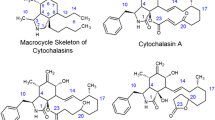Abstract
Taxol is a clinically active anticancer drug, which exerts its cytotoxicity by the unique mechanism of polymerizing tubulin monomers into microtubules and stabilizing microtubules. Our studies with ovarian (hamster CHO and human A2780) cells showed that taxol is a phase-specific agent that is much more cytotoxic to mitotic cells than interphase cells. First, the dose-survival pattern of taxol resembled that of other phase-specific agents, in which cell-kill reached a plateau at a certain concentration. This suggests that the asynchronous cell population consists of a taxol-sensitive (presumably mitotic) fraction and a taxol-resistant fraction. Second, the cells were more responsive to increased exposure time than to increased dose above the plateau concentration. Third, in both asynchrounous and synchronous cultures taxol was much more cytotoxic to mitotic than interphase (G1, S and G2) cells. Fourth, the taxol concentration needed to kill cells corresponded to the dose needed to block cells in mitosis. Although taxol blocked cells in mitosis, the mitotic block was of short duration. Cells escaped the mitotic block, without cytokinesis, and entered the next round of DNA synthesis to form multinucleated polyploid cells. Taxol was 15-to 25-fold more toxic to A2780 (human ovarian carcinoma) cells compared to CHO cells. This difference in sensitivity correlated with a higher intracellular taxol concentration in A2780 as compared to CHO as determined by either an ELISA assay or by [H3]-taxol uptake.
Similar content being viewed by others
References
Bhuyan BK (1970) The action of streptozotocin on mammalian cells. Cancer Res 30:2017
Bhuyan BK, Scheidt LG, Fraser TJ (1972) Cell cycle phase specificity of antitumor agents. Cancer Res 32:398–407
Bhuyan BK, Newell KA, Crampton SL, von Hoff DD (1982) CC1065 (NSC 298223), a most potent antitumor agent: Kinetics of inhibition of growth, DNA synthesis and cell survival. Cancer Res 42:3532
Bhuyan BK, Crampton SL, Adams EG (1983) Cell cycle effects of CC1065. Cancer Res 43:4227
Bhuyan BK, Smith KS, Adams EG, Wallace TL, Von Hoff DD, Li LH (1992) Adozelesin (U-73975), a potent new alkylating agent: Cell-kill kinetics and cell cycle effects. Cancer Chemother Pharmacol 30:348–354
Brown T, Hovlini K, Weiss G, Cagnola J, Koeller J, Rizzo J, Craig J, Phillips J, Von Hoff DD (1991) A phase I trial of taxol given by 6 h intravenous infusion. J Clin Oncol 9:1261
Bruce WR, Mecker BE, Valeriotte FA (1966). Comparison of the sensitivity of normal hematopietic and transformed lymphoma colony forming cells to chemotherapeutic agents administered in vivo. J Natl Cancer Inst 37:233–245
Citardi M, Rowinsky EK, Schaefer KL, Donehower RC (1990) Sequence-dependent cytotoxicity between cisplatin and the antimicrotubule agents taxol and vincristine. Proc Am Assoc Cancer Res 31:410
Creasey WA (1968) Modifications in biochemical pathways produced by the vinca alkaloids. Cancer Chemother Res 52:501
Crissman HA, Kissane RJ, Wanek PL, Oka MS, Steinkamp JA (1977) Flow-systems analysis and characterization of protein contents and proliferating kinetics in ascites and solid tumors. In: Neiburg HE (ed) Third International Symposium on Detection and Prevention of Cancer, pp 79–90. Dekker, New York
Holmes FA, Walters RS, Theriault RL, Forman AD, Newton LK, Raber MN, Buzdar AU, Frye DK, Hortobagyi GN (1991) Phase II trial of taxol, an active drug in the treatment of breast cancer. J Natl Cancer Inst 83:1797
Howard SMH, Theologides A, Sheppard JR (1980) Comparative effects of vindesine, vinblastine, and vincristine on mitotic arrest and hormonal response of L1210 leukemia cells. Cancer Res 40:2695
Jordan MA, Himes RH, Wilson L (1985) Comparison of the effect of vinblastine, vincristine, vindesine, and vinepidine on microtubule dynamics and cell proliferation in vitro. Cancer Res 45:2741
Jordan MA, Thrower D, Wilson L (1991) Mechanism of inhibition of cell proliferation by vinca alkaloids. Cancer Res 51:2212
Kung AL, Sherwood SW, Schimke RT (1990) Cell line specific differences in the control of cell cycle progression in the absence of mitosis. Proc Natl Acad Sci 87:9553–9557
Legha SS, Ring S, Papadopulos N, Raber M, Benzamin RS (1990) A phase II trial of taxol in metastatic melanoma. Cancer 65:2478
Lopes NM, Adams EG, Bhuyan BK (1991) Cell-kill kinetics and cell cycle effects of taxol on human and hamster ovarian cell lines. Proc Am Assoc Cancer Res 32:330
Madoc-Jones H, Mauro F (1968) Interphase action of vinblastine and vincristine: Differences in their lethal action through the mitotic cycle of cultured mammalian cells. J Cell Physiol 72:185
Manfredi JJ, Parnes J, Horwitz SB (1982) Taxol binds to cellular microtubules. J Cell Biol 94:688
McGuire WP, Rowinsky EK, Rosenshein NB, Grumbine CG, Ettinger DS, Armstrong DK, Donehower RC (1989) Taxol: a unique antineoplastic agent with significant activity in advanced ovarian epithelial neoplasms. Ann Intern Med 111:273
Peterson DF, Anderson EC, Tobey R (1968) Mitotic cells as a source of synchronized cultures. Methods Cell Physiol 3:347
Roberts JR, Allison DC, Donehower RC, Rowinsky EK (1990) Development of polyploidization in taxol-resistant human leukemic cells in vitro. Cancer Res 50:710–716
Rowinsky EK, Donehower RC, Jones RJ, Tucker RW (1988) Microtubule changes and cytotoxicity in leukemic cell lines treated with taxol. Cancer Res 48:4093–4100
Rowinsky EK, Cazenave LA, Donehower RC (1990) Taxol: a novel investigational antimicrotubule agent. J Natl Cancer Inst 82:1247
Schiff PB, Horwitz SB (1980) Taxol stabilizes microtubules in mouse fibroblast cells. Proc Natl Acad Sci 77:1561
Schiff PB, Horwitz SB (1981) Taxol assembles tubulin in the absence of exogenous guanosine 5′-triphosphate or microtubule-associated proteins. Biochemistry 20:3247
Schiff PB, Fant J, Horwitz SB (1979) Promotion of microtubule assembly in vitro by taxol. Nature 22:665
Wani MC, Taylor HL, Wall ME, Coggon P, McPhail AT (1971) Plant antitumor agents. VI. The isolation and structure of taxol, a novel antileukemic and antitumor agent fromTaxus brevifolia. J Am Chem Soc 93:2325
Author information
Authors and Affiliations
Rights and permissions
About this article
Cite this article
Lopes, N.M., Adams, E.G., Pitts, T.W. et al. Cell kill kinetics and cell cycle effects of taxol on human and hamster ovarian cell lines. Cancer Chemother. Pharmacol. 32, 235–242 (1993). https://doi.org/10.1007/BF00685842
Received:
Accepted:
Issue Date:
DOI: https://doi.org/10.1007/BF00685842




